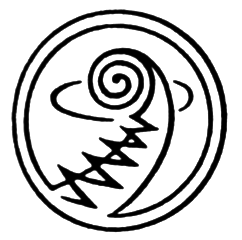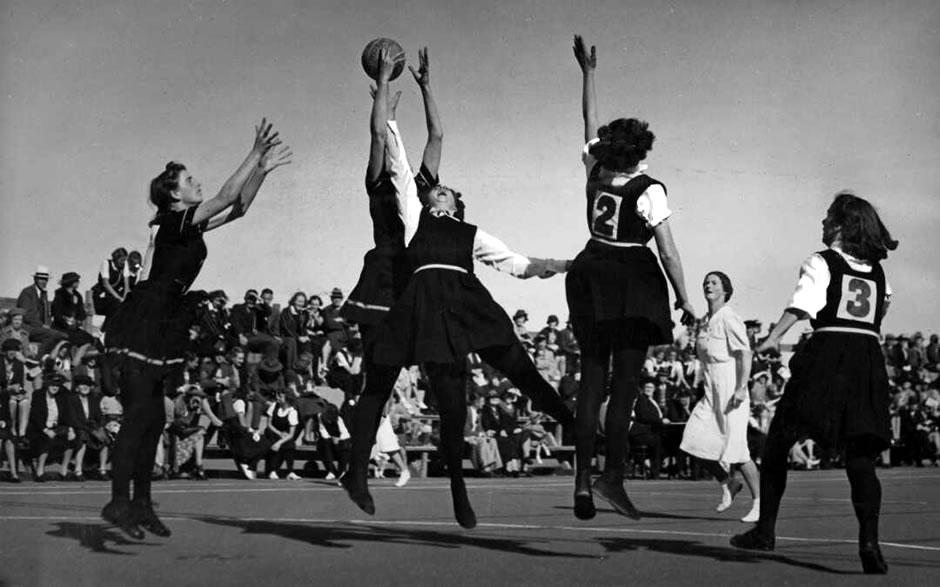
Netball New Zealand
1924 –
Theme: Sport and recreation
Known as:
- New Zealand Basketball Association
1924 – 1932 - New Zealand Basketball Association Inc.
1932 – 1970 - New Zealand Netball Association Inc.
1970 – 1990 - Netball New Zealand
1990 –
This essay written by Charlotte Macdonald was first published in Women Together: a History of Women's Organisations in New Zealand in 1993. It was updated by Charlotte Macdonald in 2018.
1924 – 1993
Outdoor basketball, now known as netball, was first played in New Zealand around the turn of the century. Reverend J. C. Jamieson, Travelling Secretary of the Presbyterian Bible Class Union, is usually credited with introducing the game here. Early matches were played by teams of girls who joined in activities run by YWCAs and bible classes. Basketball received an important boost from Herbert Milnes, principal of Auckland Training College (1906–16). A keen advocate of physical education, he brought the game into the college's programme, encouraging his predominantly female students to play it there and take it out into schools. Basketball was ideally suited to crowded school playgrounds and the limited facilities available at YWCAs; it could be played at lunchtime with a minimum of equipment by a large group of people, who could pick up the rules and skills in a short time.
Competition developed first at local level, with rules and conditions of play varying considerably from place to place. Local associations were first formed in Otago (1915), Wellington (1918), Wairoa (1917), Auckland (1920–21) and Canterbury (1921). In 1924, the four main centre associations formed the New Zealand Basketball Association (NZBA). [1] The Otago association's rules were adopted, with minor amendments, as the basis for the NZBA game. From the outset the NZBA's stated aim was to make basketball a national sport for girls and young women. The association adopted 'black with a silver fern' as its representative costume. [2]
The real beginning of New Zealand basketball came with the first New Zealand Tournament, held in Dunedin in April 1926, in conjunction with the New Zealand and South Seas Exhibition. To promote the game, Miss E. S. Batts was to give a public address on 'Basket Ball as a National Game for Girls'. Unfortunately this had to be cancelled, as did other public lectures in the Exhibition programme, because the stadium's poor acoustics made it impossible for speakers to be heard.
The New Zealand Basketball Referees' Association came into being in 1935. By then, 25 local associations had affiliated with the NZBA, registering 1112 teams. A number of other local associations were not yet affiliated with the national body. Two international fixtures were planned in the 1930s: a tour of Australia by a New Zealand representative team in 1937, and an Inter-Empire Tournament to be held as part of New Zealand's centennial celebrations in 1940. However, a polio epidemic in Australia and the outbreak of war intervened, cancelling both. The tour to Australia did go ahead in 1938; the team was captained by Meg Matangi. By this time basketball had consolidated its position as the most popular winter sport for New Zealand girls and women.

Alexander Turnbull Library, MNZ-2348.
Unidentified teams at the New Zealand netball tournament, 1940.
Two issues dominated within the association in the post-war years: the proposal to change from nine-a-side to seven-a-side teams, and the problem posed by the rapid growth in player numbers. Most other countries where the game had a following, including Australia, fielded teams of seven players, but New Zealand teams had nine-three in each section of the court. In 1948, when New Zealand hosted its first international fixture – a tour by an Australian representative team – the local and visiting sides met on unequal terms (as they had in 1938). As moves to form an international body took shape through the 1950s, pressure for a change in New Zealand escalated. Those in favour argued that as well as bringing New Zealand into line (and fair competition) with other countries, seven-a-side teams would make the game itself more challenging. Those against carried the weight of tradition, but also argued that reducing the size of the team would diminish the opportunities available to girls wanting to play basketball.
In the 1950s this was a very real consideration. In Greymouth, the 500 or so girls and young women who wanted to take part in Saturday competition vastly exceeded the town's court capacity. Until a new complex of five courts was built, the main street was blocked to traffic and converted to three basketball courts on winter Saturday afternoons. Pressure on the national tournament reached such proportions that on several occasions in the 1950s, two separate venues had to be used.
At the 1958 AGM, a motion proposing teams of seven was passed, and the change came into effect over the following two seasons. Less significant but no less controversial was the debate which also took place at that time over a change in playing attire, from the obligatory black stockings to socks.
Through the 1960s, the NZBA became responsible for sending teams to an increasing number of international events. New Zealand's profile received a boost when the national team won the championship at the second world tournament, held in Perth in 1967. These international contacts accelerated the next major decision taken by the association: to change the name of the game here from basketball to netball, thus conforming with other countries. The 1970 name change was accompanied by another important alteration in uniform – substituting skirts and blouses for the unpopular pleated gym frock.
Developments in the 1970s were relatively modest compared with those which were to transform the association and the game in the 1980s. Nevertheless, starting mid-week competition, appointing a professional national coach, hosting the 1975 International Conference and Tournament and receiving a grant from the newly-established Ministry of Recreation and Sport in 1975 were all major steps in the association's history, and indicated the beginnings of the shift from a wholly voluntary body to an increasingly professional one.
Under the leadership of Anne Taylor, president 1978–1987, the association embarked on a programme of raising the profile of netball and attracting both the media coverage and the commercial sponsorship which became vital to large sporting organisations. Live television coverage of the New Zealand/ England netball test match, immediately preceding the All Blacks/Scotland rugby test in 1981, marked a breakthrough. The association built on this success through the 1980s. A high point was reached in 1987, when the New Zealand team won the World Championships. The pace of change quickened at the end of the decade. In 1989, the association appointed its first executive director, and in 1990 changed its name to Netball New Zealand Inc., adopting a new logo and calling the national team the Silver Ferns. Shortly after, the head office moved from Wellington to Auckland, in order to be closer to its commercial sponsors. [3]
Not surprisingly, given the scale of change, some sections of the old association's membership expressed reservations. Some regretted the change of direction, the concentration on elite performance, the erosion of the autonomous female tradition of the game (as netball became increasingly promoted as a sport for men as well as women), and the growing commercialism of the sport.
By 1993, two of the main concerns of Netball New Zealand were to maintain the profile it had built up over the last decade or so, and to keep its competitive edge, in both the sporting and sponsorship arenas. The previous two or three years had not been easy in either. It was also having to cope with the consequences of its own success. Commercial operators were offering indoor netball, and non-affiliated forms of competition were springing up around the country. However, Netball New Zealand was still by far the largest women's sporting body, with 106,600 members, and the most successful in gaining media coverage and sponsorship. It was looking forward to hosting the World Tournament in 1999.
Charlotte Macdonald
1994 – 2018
From the 1990s on, netball continued to be the largest female-dominant sport in New Zealand, in numbers of players, spectators and profile. In 2018 140,000 registered players competed in five zones and 83 Netball Centres across the country, and an estimated 300,000 people played some game of netball annually. Competition spanned school, social and recreational levels through to top-level international competition, with the representative Silver Ferns at the pinnacle.
After 1993, Netball New Zealand continued to develop the sport for players at all levels. Commercial sponsorship provided crucial underwriting for the professional teams. The ANZ Bank and Sky TV were major funders by 2018, with a further 29 sponsors supporting the sport.
The ANZ Championship, a semi-professional league played by teams in New Zealand and Australia, ran from 2008 to 2016, before being dissolved and reverting to separate competitions on either side of the Tasman.
Raelene Castle, Netball New Zealand’s chief executive 2007–13, took an unprecedented step when she moved from running the largest female sport in New Zealand to heading the Canterbury Bulldogs club in the masculine domain of the National Rugby League competition centred on New South Wales, becoming the first woman to hold such a position in the NRL.
The elite national team, the Silver Ferns, consistently performed at a very high level, winning gold or silver at most Commonwealth Games once the sport became part of the Games schedule in 1998.
In 1999 New Zealand hosted the 10th Netball World Championships, the Silver Ferns losing to Australia by one goal in a nail-biting final. The game attracted the highest ever rating of any programme to that date on TV2.
In 2018, netball was continuing to compete with the wider choice of sports by then available to girls and women. It remained a popular choice, and players in the professional teams as well as the Silver Ferns enjoyed some prominence as celebrity figures in national life. Some players went on to occupy important positions beyond the sport, with Bernice Mene serving on the Flag Consultation Group (2015–16), and Irene van Dyk proving a highly popular figure in public life, while others, including Bernadine Oliver-Kerby, became recognisable media sports presenters. Meanwhile issues of national eligibility were proving controversial, with players who ‘defected’ to Australian professional teams becoming ineligible for the Silver Ferns.
Netball had become one of the few women’s sports to command a television viewing space in prime time, but the changing viewing habits of New Zealanders were likely to see changes in these arrangements. Sponsorship was generally associated with consumables and domestic products, and had not yet broken into the lucrative, albeit controversial, realm of alcohol, or into international motoring and insurance, all associated with major male sports.
Charlotte Macdonald
Notes
[1] The name changed to New Zealand Basketball Association Inc., 1932–70, and then to New Zealand Netball Association Inc., 1970–90.
[2] Minutes of NZBA inaugural meeting, 21–22 May 1924.
[3] In 1976 the association had one paid staff member; in 1992 there were ten.
Unpublished sources
Netball New Zealand Inc. records, 1924–1992, Netball New Zealand, Auckland (includes minute books, special reports, correspondence, records of affiliation, annual reports, scrapbooks)
Published sources
Butcher, Margot, 'Netball in the Nineties', North & South, June 1991, pp. 58–68
NZBA, Basketball in New Zealand: A Brief History 1906–1967, NZBA, Christchurch, 1968
NZNA, Basketball/Netball in New Zealand: A Brief History 1968–1977, NZNA, Wellington, 1978
Further information
Netball New Zealand http://www.netballnz.co.nz
Netball entry on Te Ara: https://teara.govt.nz/en/netball

Community contributions